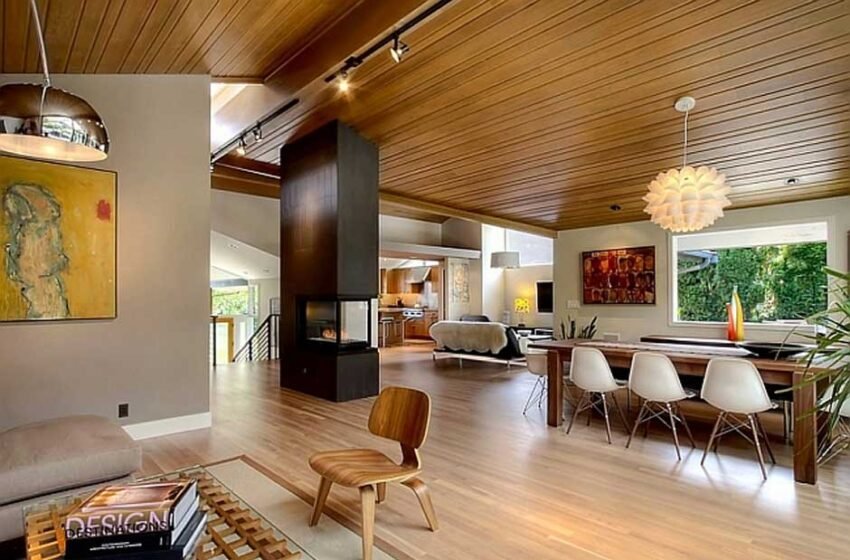Why Are So Many People Bringing Back Midcentury Style? Here’s How to Pull It Off at Home

So if you’re curious how to actually make your home lean into that era—without turning it into a set piece or an Elvis museum—let’s break it down. You don’t need a time machine, but you do need a little know-how and a willingness to care deeply about the shape of your furniture legs.
Start With the Bones, Not the Trinkets
It’s easy to assume decorating in this style just means picking up a lava lamp and calling it a day, but if you start with accessories, you’ll end up with a themed dorm room, not a well-designed space. The bones of your home—the things you can’t just toss into a basket when company comes over—are where you should focus first.
Think about your floors. Hardwood or something that at least mimics it will help set the tone. Wall color matters too. White works great, but so do soft greens, mustard yellows, or even a dusty pink if you’re feeling brave. Lighting? Absolutely essential. Swap out those builder-grade ceiling lights for pendant lights with personality. Nothing too fancy—think curved metal or simple cone shapes with a retro vibe.
Furniture should be low-profile, clean-lined, and made of wood that feels like it had a former life in a cigarette ad. It’s not about finding the most expensive original pieces from an estate sale (although more power to you if you do), but about keeping it simple, functional, and with enough character to suggest you know what you’re doing.
Let the Living Room Be the Star
If you’re going to go all in, let your living room take the lead. It’s the space most people see, and it’s where midcentury design really shows off. This doesn’t mean tossing everything you own and starting from scratch. It means choosing one or two strong pieces to anchor the room—maybe a sleek walnut coffee table or a vintage-style couch with tufted cushions and arms you could land a plane on.
Then layer it in. A shag rug underfoot. Drapes that hit just above the floor with bold geometric patterns. Maybe a sunburst clock you found online and told yourself was too much, but bought anyway. That’s where the fun starts. Your goal is to create a space that looks like people actually live there, people who might casually have a record player spinning in the corner and a half-finished crossword on the side table.
Don’t forget your lighting here, either. Lamps with sculptural bases and warm bulbs do a lot of heavy lifting. They soften the vibe and make the whole space feel like the right place to drink a Negroni after 5 p.m.
And if you’re working from home, a midcentury-inspired WFH office setup will make everything feel more intentional. A solid wood desk, a proper chair that doesn’t look like it belongs in a corporate cubicle, and a cool lamp will go a long way toward making your Zoom background the envy of your team.
The Kitchen and Dining Room Can Still Feel Vintage Without Giving Up Modern Perks
You don’t have to throw out your blender or hide your air fryer in shame. Midcentury kitchens were designed around efficiency, and there’s no reason yours can’t reflect that while still feeling like Betty Draper might walk in at any minute.
Cabinets with flat fronts and simple hardware are easy enough to find. If you can, opt for real wood—or at least something that looks close enough when the light hits it right. Backsplashes in bold tile, maybe even in avocado green or powder blue, work surprisingly well in modern homes. And yes, if you can find an old diner-style table or something with hairpin legs, your dining area just leveled up without even trying.
Accent with vintage-looking dishware or canisters, but don’t let it turn into a history exhibit. The charm is in mixing eras enough to keep it playful. Nobody wants to eat breakfast next to a collection of antique kitchen tools they’re afraid to touch.
The Art Needs to Say Something—Even If It’s Just “This Guy Had Taste”
If your walls are still bare or filled with generic prints, now’s the time to think bigger. One of the easiest ways to make your home feel like it stepped out of the 60s (but still lives in the now) is with art that tells a story. Think bold. Think colorful. Think punchy enough to stop someone mid-sentence.
There’s a whole world of original pop art drawings for sale that won’t cost you your firstborn child. This kind of art doesn’t whisper; it talks loudly and usually with a little wink. A well-placed piece above your sofa or in your hallway can do more to define a room than any pillow ever will. And unlike mass-produced prints, these add a bit of edge to your space—a reminder that midcentury wasn’t all beige and polite. It had teeth.
Bedrooms Deserve That Same Vintage Vibe—But Softer
Don’t stop the retro revival at the door. Your bedroom might not be where guests spend time, but it’s where you do, and you deserve a space that feels intentional. Keep the furniture simple. A platform bed with wooden legs and matching side tables with curved edges fits the bill. Soft lighting, cozy quilts in funky patterns, and a few framed prints on the walls will make the whole thing feel put-together without looking like you tried too hard.
Linens in warm neutrals or muted jewel tones tend to play best with the midcentury look. Avoid anything that looks too trendy or fussy. This isn’t the time for layers of throw pillows you have to launch off the bed every night just to sleep.
Add a little radio or vintage-style clock, maybe a piece of pottery on the dresser, and call it done. The bedroom doesn’t need to scream retro. It just needs to hum along with the rest of the house.
Finishing Touches That Feel Like You
In the end, what makes a midcentury home feel authentic isn’t just what you buy—it’s how you live in it. It’s the books on the shelf that show your taste hasn’t been entirely curated by an algorithm. It’s the record leaning next to the player because you never bothered to file it back. It’s the slightly-too-full ashtray on the patio, even if no one’s smoked in years.
Style from the 50s and 60s doesn’t just look good. It makes a statement without shouting. It invites you in. And if you do it right, it’ll look like it was always meant to be there—even if you did just drag it home from an antique mall last weekend.





